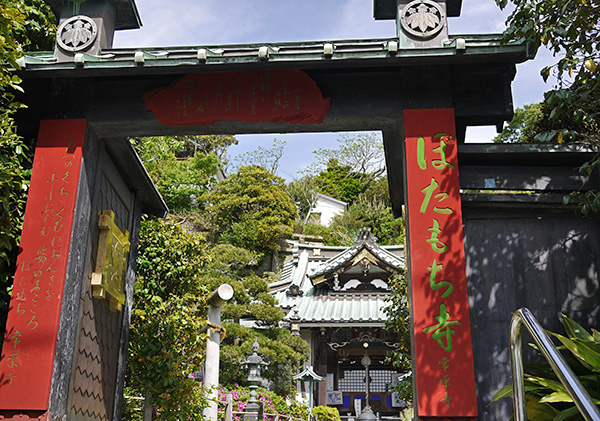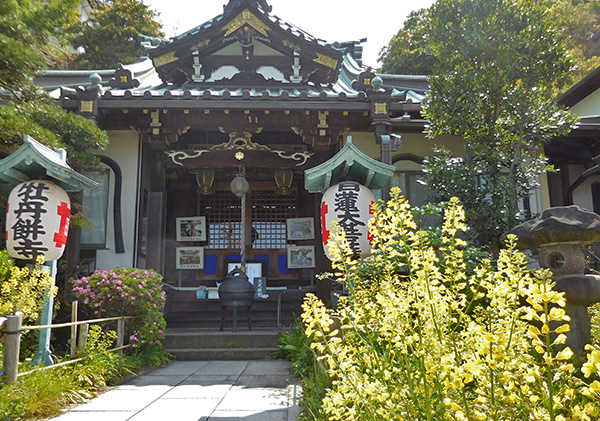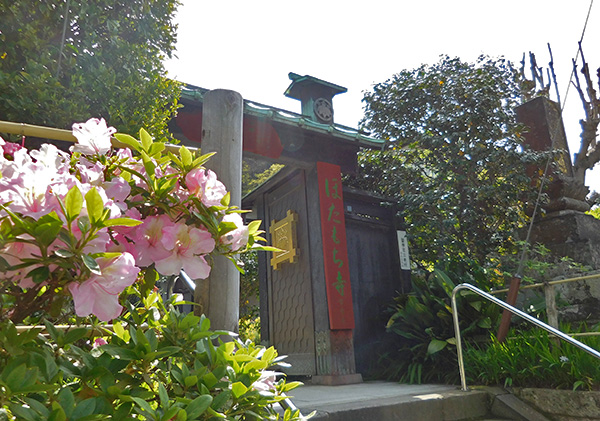Jo-eiji
| Official Name | E-um-zan Jo-eiji {Pronounced eh-um-zan joe-a-gee} |
|---|---|
| Religious sect | Nichiren sect, Buddhism |
| Founded | in 1606 by Unknown |
| Founding priest | Nissho {nis'shoh} |
| Main object of worship | Statues of Priest Nichiren etc. |
| Address | 12-11 Omachi 1-chome, Kamakura, Kanagawa 248-0007 (show route from current location ) |
| Location | 1,000 meters southeast of Kamakura Station |
| Time needed to get there | 15 minutes |
| Admission | Free |
| Open | 6:00 - 16:30 |
| Phone number | 0467-22-4570 |
| Restrooms | Not available |
Historical Overview
The Temple was erected in 1606, rather new in Kamakura, but the story dates from the 13th century. There was an observatory deck on this site which was built for Yoritomo Minamoto (1147-1199), the founder of Kamakura Shogunate. In case bird-releasing games were held at the beach of Kamakura, he came over here and watched the event. Serving him and his guests was a nun called Nichiei {nee-chee-a} (1187-1274).
In 1271, the year which was unforgettable for the Nichiren Sect Buddhists, Priest Nichiren (1222-1282), the founder of the Nichiren sect, was sentenced to death on charges of his fierce criticism against the government policy. He had also reprimanded all other religious sects saying they were fallacious, false and even dangerous to the welfare of the country. True Buddhism is, he argued, in the Lotus Sutra and unless the government follow his suggestion, the country would continue to suffer natural disasters and social unrest.
On September 12 of the year, Priest Nichiren was on the way to the execution site at Tatsunokuchi {tah-tsu-no-koo-chee} located at the west-end of Kamakura, passing near this observation deck. The devout gathered here to see him last and say good-by. Suddenly appeared before him was Nun Nichiei, an ardent devotee of Priest Nichiren, and presented Botamochi {bo-tah-mo-chee} or rice-cake dumplings covered with sesame paste. It was obvious to everybody that he would be executed within hours. However, she believed that the great Priest would survive, come hell or high water, with his messianic charisma. Yes, a miracle occurred at the last moment. He was brought down to the site for beheading that night, and the executioner hold up the sword to decapitate, when the area was hit by a stroke of lightning. Back then, lightning was thought one of the most feared super-natural powers or a divine act. The executioner was terrified and had to suspend the execution. Priest Nichiren's life was thus saved. His followers believed that the Botamochi Nun Nichiei gave to Priest Nichiren must have saved his life.
In reality, Nichiei entered nunhood after her husband died. He was also a pious devotee of Priest Nichiren. Incidentally, she had a younger brother Nissho (1221-1323) by name (same name as the founding priest of Joeiji in alphabet, but a different priest) . He was one of the Six Great Disciples of Priest Nichiren and founded Jissoji, another Nichiren sect temple.
Thereafter, the deck was owned by Myohonji, located 150-meter north of the Temple. (Nun Nichiei's younger sister was wife of Yoshimoto Hiki {yo-she-mo-toh he-key}, the founder of Myohonji). Nearly 340 years after the day of Tatsunokuchi persecution, Priest Nissho (1569-1617), then 14th chief priest of Myohonji, erected this Joeiji in 1606 together with a temple school in commemoration of Nun Nichiei's deed and Priest Nichiren's persecution.
The name Jo-ei came from her posthumous name of Myojo Nichiei {myo-joe nich-a} . The temple school was moved in 1689 to Ikegami Honganji, the mother temple of Nichiren sect, located in Ota Ward, Tokyo, where Priest Nichiren passed away in 1282. Shortly afterwards, another nun named Nichiyu {nee-chee-you} , a daughter of powerful samurai family, rebuilt the Temple. One literature says, therefore, that the founding priest of the Temple should be Nun Nichiyu.
On September 12 every year, Joeiji holds a memorial service for Priest Nichiren. The devout cook Botamochi and distribute to visitors after offering it to the altar in honor of Priest Nichiren. Joeiji has traditionally been dedicating this Botamochi to the statue of Priest Nichiren at Ryukoji where another memorial service takes place on this particular day.
Nun Nichiei and her husband, who was a retainer of Sixth Shogun Munetaka {moo-neh-tah-kah} (1242-1274), were buried here and their Gorinto {go-rin-toh} (five-tier stupa) tombs are placed beside the main hall.
The objects of worship are statues of Priest Nichiren, the tablet inscribed with the words Nam-myoho-ren-ghe'kyo and other statues of Buddha and Nun Nichiei. The Temple also own a bell cast in 1248 (probably brought here from somewhere else since the Temple was built in 1606), but is kept at the Kamakura Museum.




